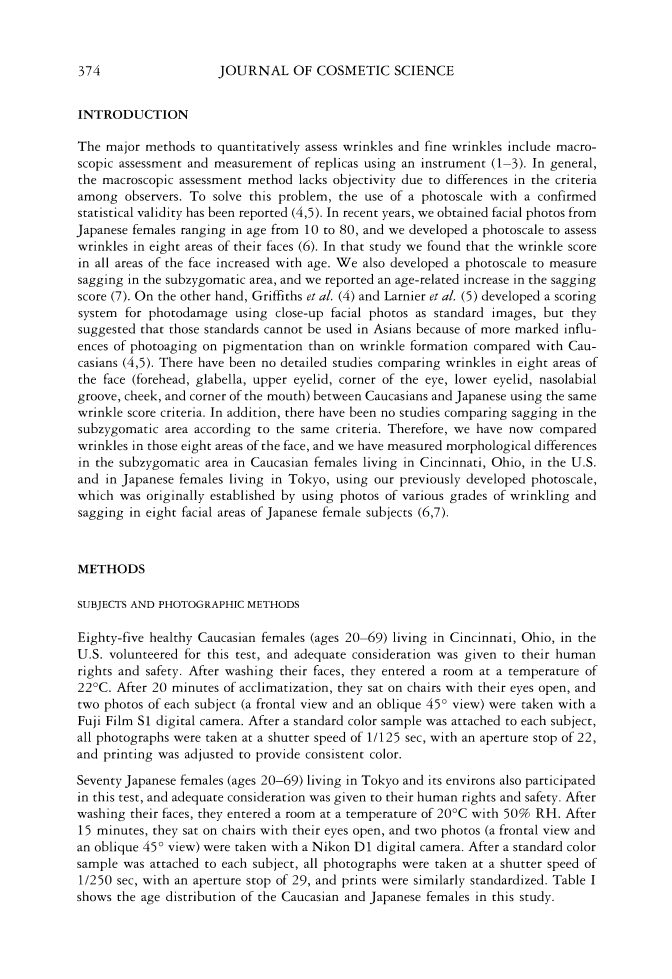]. Cosmet. Sci., 55, 373-385 Guly/August 2004) Comparison of age-related changes in wrinkling and sagging of the skin in Caucasian females and in Japanese females KAZUE TSUKAHARA, TSUTOMU FUJIMURA, YASUKO YOSHIDA, TAKASHI KITAHARA, MITSUYUKI HOTTA, SHIGERU MORIWAKI, PAMELA S. WITT, F. ANTHONY SIMION, and YOSHINORI TAKEMA, Biological Science Laboratories, Kao Corporation, Tochigi, Japan (K. T., T.F., Y. Y., T.K., M.H., S.M., Y. T.), and The Andrew Jergens Company, Cincinnati, Ohio (P.S. W., F.A.S.). Accepted for publication May 21, 2004. Synopsis We compared age-related changes in wrinkles in eight areas of facial skin (forehead, glabella, upper eyelid, corner of the eye, lower eyelid, nasolabial groove, cheek, and corner of the mouth) and sagging in the subzygomatic area of Caucasian females and of Japanese females. The subjects studied included 85 healthy Caucasian females (ages 20-69 years) living in Cincinnati in the U.S. and 70 Japanese females (ages 20-69 years) living in Tokyo. Photos of the face in frontal and in oblique 45 ° views were analyzed. Wrinkles in the face and sagging in the subzygomatic area were graded on Japanese photoscales, respectively, by the same experienced observer. The wrinkle score increased with age in all eight areas of the face examined in Caucasian females as well as in Japanese females. In the group aged 20-29 years, the wrinkle score in each area was significantly higher in Caucasian females than in Japanese females. The wrinkle scores in the forehead, glabella, upper eyelid, and corner of the eye were similar at advanced ages between the two groups, while the wrinkle scores in lower areas of the face (lower eyelid, nasolabial groove, cheek, and corner of the mouth) were markedly higher in Caucasian females than in Japanese females in each age group, and reached an upper limit at advanced ages in Caucasian females. The sagging score also increased with age in Caucasian females as well as in Japanese females. The sagging score was significantly higher in Caucasian females than in Japanese females in the groups aged 40 years or more. These results suggest more marked wrinkle formation in all areas of the face in younger age groups of Caucasian females living in North America than in Japanese females living in Tokyo. In particular, Caucasian females showed marked age-related wrinkle formation in the lower areas of the face, probably due to sagging in the subzygomatic area, which suggests a higher susceptibility to sagging in the subzygomatic area of Caucasian females. Address all correspondence to Kazue Tsukahara. 373
374 JOURNAL OF COSMETIC SCIENCE INTRODUCTION The major methods to quantitatively assess wrinkles and fine wrinkles include macro scopic assessment and measurement of replicas using an instrument (1-3). In general, the macroscopic assessment method lacks objectivity due to differences in the criteria among observers. To solve this problem, the use of a photoscale with a confirmed statistical validity has been reported (4,5 ). In recent years, we obtained facial photos from Japanese females ranging in age from 10 to 80, and we developed a photoscale to assess wrinkles in eight areas of their faces (6). In that study we found that the wrinkle score in all areas of the face increased with age. We also developed a photoscale to measure sagging in the subzygomatic area, and we reported an age-related increase in the sagging score (7). On the other hand, Griffiths et al. (4) and Larnier et al. (5) developed a scoring system for photodamage using close-up facial photos as standard images, but they suggested that those standards cannot be used in Asians because of more marked influ ences of photoaging on pigmentation than on wrinkle formation compared with Cau casians (4,5). There have been no detailed studies comparing wrinkles in eight areas of the face (forehead, glabella, upper eyelid, corner of the eye, lower eyelid, nasolabial groove, cheek, and corner of the mouth) between Caucasians and Japanese using the same wrinkle score criteria. In addition, there have been no studies comparing sagging in the subzygomatic area according to the same criteria. Therefore, we have now compared wrinkles in those eight areas of the face, and we have measured morphological differences in the subzygomatic area in Caucasian females living in Cincinnati, Ohio, in the U.S. and in Japanese females living in Tokyo, using our previously developed photoscale, which was originally established by using photos of various grades of wrinkling and sagging in eight facial areas of Japanese female subjects (6,7). METHODS SUBJECTS AND PHOTOGRAPHIC METHODS Eighty-five healthy Caucasian females (ages 20-69) living in Cincinnati, Ohio, in the U.S. volunteered for this test, and adequate consideration was given to their human rights and safety. After washing their faces, they entered a room at a temperature of 22°C. After 20 minutes of acclimatization, they sat on chairs with their eyes open, and two photos of each subject (a frontal view and an oblique 45° view) were taken with a Fuji Film Sl digital camera. After a standard color sample was attached to each subject, all photographs were taken at a shutter speed of 1/125 sec, with an aperture stop of 22, and printing was adjusted to provide consistent color. Seventy Japanese females (ages 20-69) living in Tokyo and its environs also participated in this test, and adequate consideration was given to their human rights and safety. After washing their faces, they entered a room at a temperature of 20°C with 50% RH. After 15 minutes, they sat on chairs with their eyes open, and two photos (a frontal view and an oblique 45° view) were taken with a Nikon Dl digital camera. After a standard color sample was attached to each subject, all photographs were taken at a shutter speed of 1/250 sec, with an aperture stop of 29, and prints were similarly standardized. Table I shows the age distribution of the Caucasian and Japanese females in this study.
Purchased for the exclusive use of nofirst nolast (unknown) From: SCC Media Library & Resource Center (library.scconline.org)






































































































